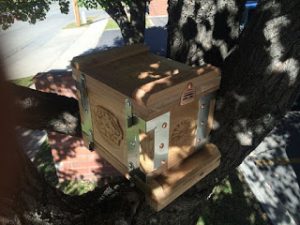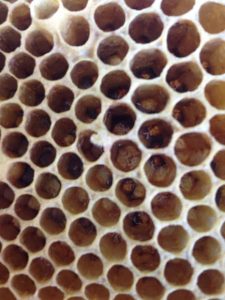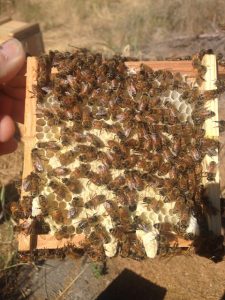Some have asked about how we solve a laying working problem in a beehive. This can be a costly problem, and a fatal issue which can end your beekeeping season.
 |
| Eco Bee Box Mini Urban Beehive. |
What happens:
When a colony goes queen-less for a period of time, about 20 days, a number of worker bees (unfertilized females) begin to lay eggs. These eggs are raised and become drones. Drones do little to aid a colony and consume lots. Quickly the frames are changed to drone cells which look like popping eyes. Slowly the worker bees diminish and all you see are drones. The drones eat up every available resource and are unable to defend then move to another colony. These drones raised in worker bee cells are viewed as poor sources for mating.
How to identify you have a laying worker:
First off it is impossible to find all the laying workers as they look like the other bees. At times you can catch one as it is sticking its abdomen into a cell, but there are usually many. When looking into a cell you will see many eggs, some on the walls, many in the bottom laying each direction, almost like they were thrown in. Some young queens can lay more than one egg in a cell as she is eager to produce and nowhere to put them. The double eggs in a single cell laid by a queen are common. Usually if you see more than 3 eggs in a cell, a laying worker environment has begun. How many laying workers are there? Anywhere from one to many.
 |
| See if you can count how many eggs are in each cell. Laying worker. This is a honey bee colony that is queenless. |
What others try:
Others try to save the colony by introducing a new queen, which usually gets killed. Still, others try to introduce a frame of brood, but it fails as well as the colony feels it has a queen or the laying workers attack it. We have heard some suggest taking the colony 15′ away from the spot and shaking out every bee, as the laying workers won’t make it back. The thought is they have not left the hive so they won’t know how to return. This is ineffective because 1) there are many laying workers, and 2) if just one of those laying workers returns you are still in the same boat. 3) the laying workers will follow their family back to the hive. 4) at times some of the laying workers join a close-by hive and end up killing that queen. Another suggested solution is adding the colony to another colony by paper separation or outside frames, but then you stand a risk of having the good colony over-run by drones and your queen killed by the laying workers.
Chubak method:
During the day carefully take the entire colony and place it at least 25 feet away, with the hive in the same positioning to the sun. Take a mini hive, or you can take a nuc, and put a frame of brood in it, bees too if available, and place it exactly where the laying worker hive used to be. The field bees will return to the spot they knew. The laying workers don’t know anything changed. If the bees reorient to the new position, do it again. After the majority of the field bees are saved in the new location and hive, let the colony with the laying workers and drones deplete themselves, or you can kill them. The drones will migrate to other colonies and are permitted to do so. Again, the drones are viewed as poor mating options as they were raised in worker cells instead of drone cells. Try to prevent the laying workers from migrating to other colonies, especially if you have small colonies nearby or mating nucs.
Problem solved. Field bees saved and strengthening a new colony. Laying workers left untouched. The new queen-less colony will take from the eggs and larva and will create a new queen of their own. It is important to note that field bees will be accepted into a new colony as long as they bring resources such as water, nectar, and pollen. Once you see the queen cell, you can invest in a mated queen and introduce her.
 |
| Queen cells made from young larva on frame supplied to a queenless colony. Laying worker solution. |
Why did a laying worker(s) begin anyway?
For some reason, the queen failed or left the colony, or was killed. We see beekeepers inspect their colony and see queen cells and think, “Hey, I don’t want them to swarm so I am going to kill all these queen cells”. The problem here is that once the cells are capped the old queen is gone already. A short time later no resources exist for the bees to make a new queen and you just killed all the queen cells they already had. 20 days queenless and laying workers start again.
